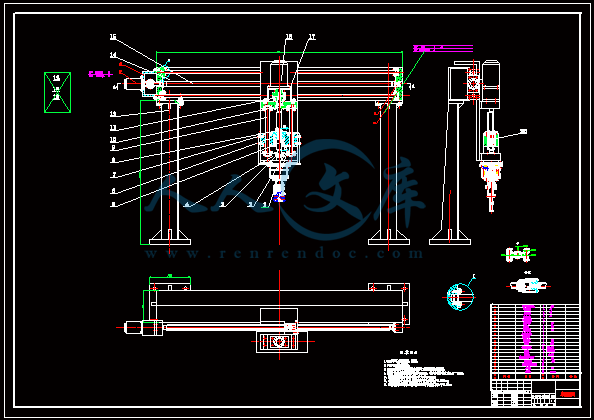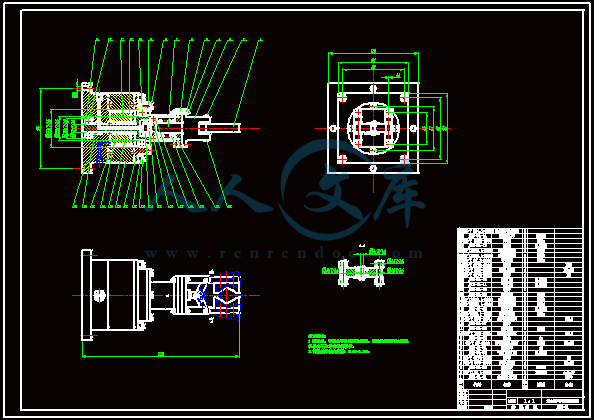资源目录

压缩包内文档预览:(预览前20页/共37页)
编号:6781817
类型:共享资源
大小:4.84MB
格式:ZIP
上传时间:2017-12-29
上传人:机****料
认证信息
个人认证
高**(实名认证)
河南
IP属地:河南
50
积分
- 关 键 词:
-
龙门
机械手
结构设计
全套
cad
图纸
- 资源描述:
-













- 内容简介:
-
ModernMechanicalEngineering,2011,1,47-55doi:10.4236/mme.2011.12007PublishedOnlineNovember2011(http:/www.SciRP.org/journal/mme)Copyright2011SciRes.MMEDesignandDevelopmentofaCompetitiveLow-CostRobotArmwithFourDegreesofFreedomAshrafElfasakhany1,2,EduardoYanez2,KarenBaylon2,RicardoSalgado21DepartmentofMechanicalEngineering,FacultyofEngineering,TaifUniversity,Al-Haweiah,SaudiArabia2TecnolgicodeMonterrey,CampusCiudadJurez,CiudadJuarez,MexicoE-mail:ashr12000ReceivedOctober19,2011;revisedNovember7,2011;acceptedNovember15,2011AbstractThemainfocusofthisworkwastodesign,developandimplementationofcompetitivelyrobotarmwithen-hancedcontrolandstumpycost.Therobotarmwasdesignedwithfourdegreesoffreedomandtalentedtoaccomplishaccuratelysimpletasks,suchaslightmaterialhandling,whichwillbeintegratedintoamobileplatformthatservesasanassistantforindustrialworkforce.Therobotarmisequippedwithseveralservomotorswhichdolinksbetweenarmsandperformarmmovements.Theservomotorsincludeencodersothatnocontrollerwasimplemented.TocontroltherobotweusedLabview,whichperformsinversekinematiccalculationsandcommunicatestheproperanglesseriallytoamicrocontrollerthatdrivestheservomotorswiththecapabilityofmodifyingposition,speedandacceleration.Testingandvalidationoftherobotarmwascarriedoutandresultsshowsthatitworkproperly.Keywords:RobotArm,Low-Cost,Design,Validation,FourDegreesofFreedom,ServoMotors,ArduinoRobotControl,LabviewRobotControl1.IntroductionThetermroboticsispracticallydefinedasthestudy,designanduseofrobotsystemsformanufacturing1.Robotsaregenerallyusedtoperformunsafe,hazardous,highlyrepetitive,andunpleasanttasks.Theyhavemanydifferentfunctionssuchasmaterialhandling,assembly,arcwelding,resistancewelding,machinetoolloadandunloadfunctions,painting,spraying,etc.Therearemainlytwodifferentkindsofrobots:aser-vicerobotandanindustrialrobotic.Servicerobotisaro-botthatoperatessemiorfullyautonomouslytoperformservicesusefultothewell-beingofhumansandequipment,excludingmanufacturingoperations2.Industrialrobot,ontheotherhand,isofficiallydefinedbyISOasanauto-maticallycontrolledandmultipurposemanipulatorpro-grammableinthreeormoreaxis1.Industrialrobotsaredesignedtomovematerial,parts,tools,orspecializedde-vicesthroughvariableprogrammedmotionstoperformavarietyoftasks.Anindustrialrobotsystemincludesnotonlyindustrialrobotsbutalsoanydevicesand/orsensorsrequiredfortherobottoperformitstasksaswellasse-quencingormonitoringcommunicationinterfaces.In2007theworldmarketgrewby3%withapproxi-mately114,000newinstalledindustrialrobots.Attheendof2007therewerearoundonemillionindustrialro-botsinuse,comparedwithanestimated50,000servicerobotsforindustrialuse3.Duetoincreaseusingofindustrialrobotarms,anevo-lutiontothattopicbegantryingtoimitatehumanmove-mentsinadetailmode.ForexampleagroupofstudentsinKoreamadeadesignofinnovationsthatroboticarmtakeaccountofdancinghand,weightlifting,Chinesecal-ligraphywritingandcolorclassification4.AnothergroupofengineersatUSAdevelopeightdegreesoffreedomrobotarm.Thisrobotisabletograspmanyobjectswithalotofshapesfromapentoaballandsimulatingalsothehandofhumanbeing5.Inspace,theSpaceShuttleRemoteManipulatorSystem,knownasSSRMSorCana-darm,anditssuccessorisexampleofmultidegreeoffreedomrobotarmsthathavebeenusedtoperformava-rietyoftaskssuchasinspectionsofthespaceshuttleusingaspeciallydeployedboomwithcamerasandsen-sorsattachedattheendeffectorandsatellitedeploymentandretrievalmanoeuvresfromthecargobayofthespaceshuttle6.InMexico,Scientistsareontracktodesignandde-velopmanyrobotarms,andtheMexicangovernmentA.ELFASAKHANYETAL.48estimatesthatinMexicothereareabout11,000roboticarmsusedindifferentindustrialapplications.However,theexpertsthinkthattheapogeeoftherobotarmsisnotonlyofhigherquality,butalsoaccurately,repeatability,andstumpycost.Mostrobotsaresetupforanoperationbytheteach-and-repeattechnique.Inthismode,atrainedoperator(pro-grammer)typicallyusesaportablecontroldevice(ateachpendant)toteacharobotitstaskmanually.Robotspeedsduringtheseprogrammingsessionsareslow.Thepresentworkispartofatwo-phaseproject,whichrequiresamobilerobottobeabletotransportthetoolsfromthestorageroomtotheindustrialcell.Inthisphaseintheproject,whichcarriedoutatMonterreyUniversityofTechnology,Mexico,themainfocuswastodesign,developmentandimplementationofanindustrialroboticarmwithstumpycost,accurateandsuperiorcontrol.Thisrobotarmwasdesignedwithfourdegreesoffreedomandtalentedtoaccomplishsimpletasks,suchaslightmate-rialhandling,whichwillbeintegratedintoamobileplat-formthatservesasanassistantforindustrialworkforce.2.MechanicalDesignThemechanicaldesignoftherobotarmisbasedonarobotmanipulatorwithsimilarfunctionstoahumanarm6-8.Thelinksofsuchamanipulatorareconnectedbyjointsallowingrotationalmotionandthelinksofthema-nipulatorisconsideredtoformakinematicchain.Thebusinessendofthekinematicchainofthemanipulatoriscalledtheendeffectororend-of-arm-toolinganditisanalogoustothehumanhand.Figure1showstheFreeBodyDiagramformechanicaldesignoftheroboticarm.Asshown,theendeffectorisnotincludedinthedesignbecauseacommerciallyavailablegripperisused.ThisisbecausethattheendeffectorisoneofthemostcomplexFigure1.Freebodydiagramoftherobotarm.partsofthesystemand,inturn,itismucheasierandeconomicaltouseacommercialonethanbuildit.Figure2showstheworkregionoftheroboticarm.Thisisthetypicalworkspaceofarobotarmwithfourdegreeoffreedom(4DOF).Themechanicaldesignwaslimitedto4DOFmainlybecausethatsuchadesignal-lowsmostofthenecessarymovementsandkeepsthecostsandthecomplexityoftherobotcompetitively.Ac-cordingly,rotationalmotionofthejointsisrestrictedwhererotationisdonearoundtwoaxisintheshoulderandaroundonlyoneintheelbowandthewrist,seeFigure1.Therobotarmjointsaretypicallyactuatedbyelectri-calmotors.Theservomotorswerechosen,sincetheyin-cludeencoderswhichautomaticallyprovidefeedbacktothemotorsandadjustthepositionaccordingly.However,thedisadvantageofthesemotorsisthatrotationrangeislessthan180span,whichgreatlydecreasestheregionreachedbythearmandthepossiblepositions9.Thequalificationsofservomotorswereselectedbasedonthemaximumtorquerequiredbythestructureandpossibleloads.Inthecurrentstudy,thematerialusedforthestruc-turewasacrylic.Figure3showstheforcediagramusedforloadcalcu-lations.Thecalculationswerecarriedoutonlyforthejointsthathavethelargestloads,sincetheotherjointswouldhavethesamemotor,i.e.themotorcanmovethelinkswithoutproblems.Thecalculationsconsideredtheweightofthemotors,about50grams,exceptfortheweightofmotoratjointB,sinceitiscarriedoutbylinkBA.Fig-ure4showstheforcediagramonlinkCB,whichcon-tainsthejoints(BandC)withthehighestload(carrythelinksDCandED)andthecalculationsarecarriedoutasfollows.Figure2.Workregionoftheroboticarm.Copyright2011SciRes.MME49A.ELFASAKHANYETAL.Figure3.Forcediagramofrobotarm.Figure4.ForcediagramoflinkCB.Thevaluesusedforthetorquecalculations:Wd=0.011kg(weightoflinkDE)Wc=0.030kg(weightoflinkCD)Wb=0.030kg(weightoflinkCB)L=1kg(load)Cm=Dm=0.050kg(weightofmotor)LBC=0.14m(lengthoflinkBC)LCD=0.14m(lengthoflinkCD)LDE=0.05m(lengthoflinkDE)PerformingthesumofforcesintheYaxis,usingtheloadsasshowninFigure4,andsolvingforCYandCB,seeEquations(1)-(4).Similarly,performingthesumofmomentsaroundpointC,Equation(5),andpointB,Equa-tion(6),toobtainthetorqueinCandB,Equations(7)and(8),respectively.gydmcmYFLWDWCC0(1)21.141kg9.8ms11.18NYC(2)0ydmcmBBFLWDWCWgC(3)21.171kg9.8ms11.4758NBC(4)220cCDDEcDCDCDDEmCDcWLLMWLLLLDLM(5)2202DEBBCCDDEDBCCDCDmBCCDcBCBCmBCBBLMLLLLWLLLDLLWLLCLWM(6)1.968Nm278.6ozincM(7)3.554Nm503.38ozinBM(8)Theservomotorthatwasselected,basedonthecal-culations,istheHextronikHX12K,whichhasatorqueof280oz/in.Thismotorwasrecommendedbecauseitismuchcheaperthananyothermotorwithsamespecifica-tions.SinceweneedmoretorqueatjointB,seeEquation(8),weusedtwomotorsatpointBtocomplywiththetorquerequirements;however,onemotorisenoughfortheotherjoints.UsingtwomotorsatjointBismuchcheaperthanusingonebigmotorwith560oz/in.Otherrelevantcharacteristicsofthemotors,whichcanbeshowninFigure5,arethattheycanturn60degreesin130mil-lisecondsandtheyhaveaweightof47.9gramseach.Oncetheinitialdimensionsfortherobotarmandthemotorweredefined,thedesignwerecarriedoutusingtheSolidWorksplatform;designshouldcarefullytakeintoaccountthethicknessoftheacrylicsheetandthewaythatthepieceswouldbeattachedtoeachother.Theacrylicsheetusedtomaketherobotis1/8thicknessandFigure5.Servomotor.Copyright2011SciRes.MMEA.ELFASAKHANYETAL.50thatthinsheetwaschosenbecauseiteasierformachiningandlessweightwithagoodresistance.Duringdesign,wefacedsomedifficultiesduetothewayofjoiningthinacrylicpartsstrongly.Itwasneededtoolstoburnandjointheacrylicpartsandthatwerentavail-ableandtheteamconsideredthatamechanicaljunctionbasedonscrewsandnutswouldbemuchstrongthanotheralternatives,suchasglueforexample.Inordertoaccom-plishthis,asmallfeaturewasdesignedwhichallowedtofastentheboltswiththenutswithouthavingtoscrewinthethinacryliclayer.TheresultofthisprocesswasthetridimensionaldesignshowninFigure6.Byendofdesign,eachpartwasprintedinfullscaleincardboardpaperandthenweverifiedallthedimensionsandtheinterfacesoftheassembly.Inturn,webuiltthefirstprototypeoftherobotarm.Next,partsoftherobotarmweremachinedfromtheacrylicsheetusingacircu-larsawandDermaltools.Thedetailingonthepartswasdoneinaprofessionalworkshopsincethepartsofrobotarmweretoosmallanditisnotaneasyforaccomplish-ingsuchsmallandaccuratecuts.Duringassemblingtherobotpartswiththemotors,fewproblemspopup.Therewerecriticalpointsthatdidnotresistthefasteningand,inturn,maybreakdown;hence,reinforcementsinthesepointswereconsidered.ThefinalresultoftherobotarmisshowninFigure7.3.RobotArmInverseKinematicsTovalidatetherightpositioningoftheroboticarm,in-versekinematicscalculationsarecarriedout.Suchcal-culationsareusedtoobtaintheangleofeachmotorfromFigure6.Robotarm3Dmodel.Figure7.Robotarmcompleteassembly.apositiongivenbyusingtheCartesiancoordinatesys-tem,asshowninFigure8.Eachmotorwillhaveaspe-cificfunction:themotorlocatedintheAunionpositionsthefinalelementintheyaxis,themotorsBandCposi-tionsthefinalelementinthexandzaxis.Theproblemwassimplifiedbyusingthexzplane,asshowninFigure9.Inwhichthefollowingknownvaluesweredefined9:LAB:theforearmlength.LBC:thearmlength.z:thepositioninthezaxis.x:thepositioninthexaxis.y:thepositionintheyaxis.Usingtrigonometryrelations,asshowninFigure9,themotorangles2and1areobtained,asseeninEqua-tions(9)and(10).2222180arcCos2LABLBCxzLABLBC2(9)222122arcTanarcCos2zLABLBCxxLABxz2(10)0arcTanyx(11)ThemotorBisgoingtouse1andthemotorCisgo-ingtouse2.TheangleforthemotorAiscalculatedasCopyright2011SciRes.MME51A.ELFASAKHANYETAL.Figure8.Coordinatesystem.Figure9.xzPlane.seeninEquation(11).Withthesecalculations,theanglesofservomotorsareobtainedandinturntheytaketheac-tiontomovethewholestructuretothespecificposition.4.End-EffectorSelectionTheendeffectorisprobablyoneofthemostimportantandmostcomplexpartsofthesystem.Wisely,itismuchea-sierandeconomicaltouseacommercialonethanbuildit.Theendeffectorvariesmainlyaccordingtotheappli-cationandthetaskthattherobotarmaccomplishesfor;itcanbepneumatic,electricorhydraulic.Sinceourrobotarmisbasedinanelectricsystem,wemaychooseelectricba-sisofendeffector.Besides,themainapplicationofoursystemishandling,accordingly,therecommendedtypeofourendeffectorisagripper,asshowninFigure10.Pleasenotethattheendeffectoriscontrolledbyaservomotorand,inturn,thetotalservomotorsusedforourrobotarmwillbe5motorsthatmovethestructure.Figure10.Gripperwithservo.5.RobotArmControlTherobotarmscanbeautonomousorcontrolledmanually.Inmanualmode,atrainedoperator(programmer)typi-callyusesaportablecontroldevice(ateachpendant)toteacharobottodoitstaskmanually.Robotspeedsduringtheseprogrammingsessionsareslow.Inthecurrentworkweenclosedthebothmodes.Thecontrolforthepresentedrobotarmconsistsbasi-callyofthreelevels:amicrocontroller,adriver,andacom-puter-baseduserinterface.Thissystemhasuniquechar-acteristicsthatallowflexibilityinprogrammingandcon-trollingmethod,whichwasimplementedusinginversekinematics;besidesitcouldalsobeimplementedinafullmanualmode.TheelectronicdesignofcontrolisshowninFigure11.ThemicrocontrollerusedisanAtmega368whichcomeswithadevelopment/programmingboardnamed“Arduino”,asshowninFigure12.TheprogramminglanguageisverysimilartoCbutincludesseverallibrary-iesthathelpinthecontroloftheI/Oports,timers,andserialcommunication.Thismicrocontrollerwaschosenbecauseithasalowprice,itisveryeasytoreprogram,theprogramminglanguageissimple,andinterruptsareavailableforthisparticularchip.Thedriverusedisasix-channelMicroMaestroservocontrollerboard.Itsupportsthreecontrolmethods:USBfordirectconnectiontoacomputer,TTLserialforusewithembeddedsystems,suchastheArduinomicrocon-troller,andinternalscriptingforself-containedandhostcontroller-freeapplications.Thiscontroller,asshowninFigure13,includesa0.25sresolutionforpositionandbuilt-inspeedandaccelerationcontrol.Copyright2011SciRes.MMEA.ELFASAKHANYETAL.52Figure11.Electronicschemeofcontrol.Figure12.Arduinomicrocontrollerboard.Figure13.Servocontrollerdriver.Theuserinterfacedependsonthecontrolmethodused,i.e.,inversekinematicsorafullmanualmode.Inthefol-lowing,eachinterfaceisdescribed:5.1.InverseKinematicsControlInthiscontrolmethod,theuserinputsthecoordinatesys-tempositionwherethegrippershouldbe.Asconsequence,interfaceisgeneratedwithLabviewthroughavisualuser,asshowninFigure14.Theprogramautomaticallyper-formstheinversekinematicscalculationstoobtaintheanglesthateachmotorshouldhaveandthensendsacommandeithertothemicrocontrollerordirectlytothedriverthatwillmovetherobottothespecifiedposition.CommunicationisperformedwiththeRS-232protocol.Inthefollowing,youmayseetheLabviewuserinterfaceinputsandoutput.TheLabviewuserinterfaceinputsare:xaxisposition.yaxisposition.zaxisposition.Gripperopening.Gripperattackangle.Serialport.TheLabviewuserinterfaceoutputsare:MotorAangle.MotorB1angle.MotorB2angle.MotorCangle.Attackangle.Gripperangle.Suchoutputvariablesaretreatedandsentbyanappro-priateway,sothatinformationcanbeinterpretedinacorrectmanner.Theoutputsaresentviatheserialportwhichiscommunicatedwiththecontroller.Whenthebut-ton“Move”isclicked,aprocesswilltakeplace,asshowninFigure15.Withthisaction,theroboticarmwillchangeitspositionaccordingtotheinputvalues.Inaddition,ithasastandbybuttonthatstopsthecommunicationcontroller.Figure14.Labviewuserinterface.Copyright2011SciRes.MME53A.ELFASAKHANYETAL.Figure15.Programprocess.Themainadvantagesofthisapproacharethatitusesanefficientwayofmovingandoffersfurthercapabilitiesthatcouldbeimplemented,suchaspositionandsequencelearning.Adisadvantage,ontheotherhand,isthatthepossiblepositionsthathavevalidanglesaftertheinversekinematicscalculationsareverylimitedbecausetheservomotorshavearestraintof180.5.2.ManualControlThistypeofcontrolisanextraoptionforoursystemthatusefulinspecificpositions.Incaseofmandatoryposi-tionsthattheinversekinematicsmodecannotcalculatetheirvalidangles,wemayusethemanualcontrolinstead.Basically,manualcontrolconsistsofaseriesofanaloginputs,suchaspotentiometers,thatareconnectedwiththemicrocontrollerwhichwillinterpretthevaluesandsendacommandtotheservodriver.Inordertoimple-mentthis,acontrolboard,asshowninFigure16,shouldbebuilttoworkasaninterfacewiththeuser.Possibleimplementationincludesateachingfeaturewherethemi-crocontrollerstorespositionsinmemoryandbyakeypadoraseriesofswitcheswemayrecallthesepositions.6.TestingandValidationSeveraltestswerecarriedouttovalidatetherobotarmanditscomponents.Thetestescoveredboththeparticularele-mentsandtheoverallsystem,asshowninFigure17.Forthemicrocontroller,thetestsareoccurredbysendingdifferentcommandsbythesoftwaretothemicrocontrol-lerandcheckchangesontheoutputwhichwasconnectedtoaservomotorthatturnedonoroffdependingonthecommand.Theservomotorsweretestedafterwardsbysendingdifferentdirectpulsestoeachservomotorandverifyingtheresponseofmovingtotherightposition.WeusedamarktoknowwheretheinitialpositionwasandthefinalFigure16.Potentiometerboard.Figure17.Robotarmtests.positionofthemotorsisdeterminedbysendingasignalwiththemicrocontrollerand,inturn,itisinterpretedbytheservoandcomparedtothesignalprovidedbytheencoder,resultingintherotationtothedesiredposition.Duringthistest,theservomotorwasinconsistencewiththerobotarmsystembecauseofanincorrectpolarization.TheservomotordriverwasalsotestedusingtheLab-viewsoftwaretosendcommandstothemicrocontrollerwhichsentthespecificcommandstothedriverwhichhadonemotorconnectedtochangethepositionaccord-ingtothecommend.Itisimportanttonoticethatatthebeginningoftheprojectadifferentservomotordriverwasselectedbutseveralproblemsrelatedtothecommu-nicationbetweenthemandthemicrocontrollerwerepre-sent.SowechooseadriverthatallowsthedatatobesentdirectlyfromthecomputertoitwithonlyaUSBwire,sothemicrocontrollerwouldonlybeusedincaseoftheimplementationofmanualcontrol.Othertestswereperformedtoverifythefunctionalityofthewholesystem,asshowninFigure18.ThosetestsCopyright2011SciRes.MMEA.ELFASAKHANYETAL.54Figure18.Robotarminaction.wereoccurredbyintroducingaspecificpositionintheLabviewinterfaceandmeasuringthedistancebetweenareferencepointandthefinalpointinordertoverify:thecorrecttransformationfrominversetodirectkinematics,therelationshipbetweenthespecifiedanglesandthero-tationofthemotors.Testingandvalidationoftherobotarmisoneofthetasksthatrequireelongatedtimebecauseseveraliterationsareneeded.Duringourtests,manyproblemsariseas:wronganglecalculations,wrongcalibrationofthemo-tors,problemswiththephysicalangleandpositionmea-surements,andoneoftheservomotorsburnedbecauseofanoverloadthatwasntexpected.7.ResultsandDiscussionsResultsfromtherobotarmatdifferentoperatingcondi-tionsarepresentedasfollows:7.1.ServoMotorsMovementRangeThelimitsoftheservomotorswereobtainedsincespeci-ficationofthistypeofmotorscontainsthatithaslessthana180degreespan.Therealrangeforallmotorswasfoundtobeintherange125-142degrees,asshowninTable1.Thisclearlydemonstratedthatrealoperationofrobotarmisdifferentfromthestandercase.Table1.Motorangleranges.MotorAngleRangeMotorA130MotorB1135MotorB2140MotorC142MotorAttackAngle1257.2.CurrentConsumptionThecurrentconsu
- 温馨提示:
1: 本站所有资源如无特殊说明,都需要本地电脑安装OFFICE2007和PDF阅读器。图纸软件为CAD,CAXA,PROE,UG,SolidWorks等.压缩文件请下载最新的WinRAR软件解压。
2: 本站的文档不包含任何第三方提供的附件图纸等,如果需要附件,请联系上传者。文件的所有权益归上传用户所有。
3.本站RAR压缩包中若带图纸,网页内容里面会有图纸预览,若没有图纸预览就没有图纸。
4. 未经权益所有人同意不得将文件中的内容挪作商业或盈利用途。
5. 人人文库网仅提供信息存储空间,仅对用户上传内容的表现方式做保护处理,对用户上传分享的文档内容本身不做任何修改或编辑,并不能对任何下载内容负责。
6. 下载文件中如有侵权或不适当内容,请与我们联系,我们立即纠正。
7. 本站不保证下载资源的准确性、安全性和完整性, 同时也不承担用户因使用这些下载资源对自己和他人造成任何形式的伤害或损失。

人人文库网所有资源均是用户自行上传分享,仅供网友学习交流,未经上传用户书面授权,请勿作他用。
 川公网安备: 51019002004831号
川公网安备: 51019002004831号